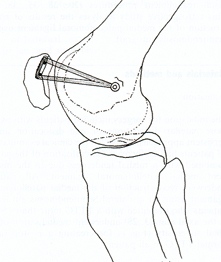
This condition occurs in young adults. The knee cap (patella) dislocation may occur with or without an injury. The anatomy (shape) and position of the knee cap and the groove in which the knee cap runs may predispose some people to knee cap dislocation.
The acute injury may involve a fracture of the patella or the groove of the patella. This will usually require emergency surgery.
This will present as a swollen knee and the knee cap usually dislocates to the outside of the knee.
The bone fragment may need to fixed back in position or removed.
If there is no fracture initial treatment will include reduction of the dislocation under sedation,rest, ice and physiotherapy.
If the knee cap redislocates in spite of good rehabilitation, surgery may be required to stabilise the knee cap followed by physiotherapy. This is usually successful at keeping the knee cap stable.
.JPG)
Patellofemoral joint
Where is the patellofemoral Joint (PFJ)?
The patellofemoral joint is at the front of the knee joint. It is the articulation between the knee cap (patella) and the front of the thigh bone (femur). Pain from the joint maybe felt at the front of the knee.
The patella makes a substantial contribution to the knee function. It is a common site of pain and instability. The function of the knee cap joint is to enable us to bend our knee comfortably and to help with bent knee activities such as getting up from a chair. It is not a weight bearing part of the knee joint, like the main part of the knee joint, but can be irritated by running and sport.
What does a patellofemoral joint (PFJ) problem feel like?
You will have pain at the front of the knee made worse by activities such as stair climbing, squatting, sitting and kneeling. You may also suffer with locking, catching, giving way, clicking or swelling.
The problem in younger people may be due to abnormal position of the knee cap(Anterior Knee Pain). In older people, the problem may be due to arthritis of the knee cap joint.
Anterior Knee Pain (AKP)
"Anterior Knee Pain" produces symptoms as outlined above. It can affect children and young adults. Pain is usually described at the front of the knee, under the kneecap or "deep inside" the knee. Occasionally pain may be at the back of the knee in the hamstring area. Clicking in this situation is not due to any serious pathology but related to knee cap movements on bending the knee.
What shows on Xrays and Scans?
Xrays and MRI scans are usually normal. There maybe indications on the scans that the kneecap may be in an abnormal position as the knee bends.
What is the treatment?
Most young patients with these symptoms can be adequately treated with physiotherapy.
What causes the pain in this condition?
The problem of anterior knee pain is thought to arise because the knee cap is not fully seated in its groove on the front of the thigh bone when the knee is bent. Muscle strengthening and stretching programs are the mainstay of treatment in order to keep the knee cap in a normal position.
Pain tends to be variable. Some days the knee may feel normal others the pain maybe severe. Both knees are usually affected. In sports people pain usually starts after activity although it may prevent people undertaking sport.
Most symptoms of anterior knee pain can be treated successfully by maintaining an exercise program as outlined above. Other helpful treatments include using a knee support, strapping the knee cap or using shoe insoles to correct flat feet.
Once a young person knows the MRI scan is normal and that the pain, although severe, is not due to anything serious such as arthritis, can usually accept the pain for some months until it resolves.
What will happen to the knee in the future?
There are a small percentage of people who continue to have pain for years and they may need to alter thier activities to control the pain or accept that the occasional pain after sporting activity. There is no strong evidence that AKP leads to degeneration or arthritis in the future.
In summary, therefore. anterior knee pain is the commonest cause of knee pain. It occurs in young people. It usually develops spontaneously and is not related to an injury. It usually affects both knees. Its made worse by bent knee activity, MRI scans are usually normal, and the treatment is physiotherapy.
Is surgery an option?
Rarely surgery maybe considered for the purposes of absolute exclusion of other causes of pain such as gristle damage on the joint surface of the patella which can be smoothed (chondroplasty), release of the patella (lateral release), release of bands in the knee (plicae) or trimming of the fat pad which may catch in the knee. It must be said that surgery is only successful in 70% of cases and must be approached with caution after full discussion with your surgeon.
Back to top